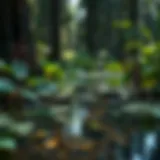Understanding the National Park Pass System


Intro
Understanding the ins and outs of the national park pass system is crucial for anyone who spends time amidst the breathtaking backdrops of America’s forests. The importance of these passes transcends mere access; they act as a lifeline for sustaining the very landscapes we cherish. For outdoor enthusiasts, whether seasoned hikers or occasional nature lovers, knowing how to navigate this system can greatly enhance their experiences.
Each year, millions flock to national parks, drawn by the breathtaking vistas and the rich ecosystems they house. However, as demand increases, so does the responsibility we bear to preserve these natural treasures. This article serves as a comprehensive guide, diving deep into the various aspects of the national park pass system and its broader implications for forestry conservation and community engagement.
Key Points to Explore:
- Different types of national park passes
- Benefits of obtaining a pass
- Application processes and eligibility criteria
- The significance of passes in supporting sustainable practices
As we delve into this narrative, we will uncover how these passes play an integral role in promoting conservation efforts and encouraging community participation. The trees we love and the wildlife we admire depend on us, and understanding this pass system is one significant step we can take towards stewardship.
Preamble to National Park Pass
Acquiring a national park pass is not merely a bureaucratic step; it's a gateway to experiencing the vast beauty and unique ecosystems of our national landscapes. This introductory section unpacks its significance, underscoring why understanding the national park pass system is essential for anyone with a penchant for outdoor adventures or a commitment to environmental conservation.
Understanding the Concept
The national park pass is essentially a ticket to a world where nature reigns supreme. From towering mountain ranges to serene lakes, each pass opens the door to a plethora of landscapes, each with its own unique features. This pass allows individuals and families to explore these natural wonders without incurring hefty entrance fees each time they venture into a park. By purchasing an annual pass, not only can one visit multiple parks, but they also contribute to the very upkeep of these treasured habitats.
Many might ask, "What’s the catch?" In truth, there are no hidden strings attached. The fees collected go directly into maintaining the parks, supporting conservation efforts, and ensuring that future generations can also revel in nature's majesty. The pass system can seem daunting at first, with various options available, but grasping the basic concept lays the groundwork for a deeper engagement with conservation efforts.
Importance in Modern Conservation
In today’s world, where the impact of urbanization and climate change is increasingly evident, the national park pass serves as a crucial tool for supporting conservation. When individuals opt to visit national parks, they indirectly become stewards of the environment. The revenue from park passes directly funds various conservation projects, ensuring that the ecosystem remains intact, habitats are preserved, and wildlife thrives.
"A national park pass can be seen as a pact between nature and outdoor enthusiasts, a way to invest in the beauty we often take for granted."
Community engagement is also another facet of this importance. By opening access to these areas, the pass facilitates a stronger connection between people and nature. It cultivates an appreciation for the environment fostered through personal experiences in the outdoors. Every visit can spark advocacy for sustainable practices, as individuals witness first-hand the delicate balance that ecosystems require.
In summary, the national park pass transcends being just a ticket; it enhances connection to the land, fosters a spirit of stewardship, and plays a vital role in the framework of modern conservation efforts. Recognizing its importance is the first step toward becoming an active participant in preserving our natural heritage.
Types of National Park Passes
Understanding the different types of national park passes available is crucial for anyone planning to explore the great outdoors. Each pass comes with its own set of benefits, making it necessary to assess which one fits your needs best. Not only do they facilitate access to the parks, but they also contribute to the overall support of conservation efforts and park maintenance.
Annual Pass Overview
The Annual Pass is possibly the most popular choice among frequent visitors to national parks. This pass offers unlimited entry into over 2,000 sites managed by the National Park Service, which covers not just parks, but also wildlife refuges and recreation areas.
A significant advantage here is the cost-effectiveness. If you plan to visit several parks within a year, the $80 fee can quickly pay for itself. For example, a trip to Yellowstone, Yosemite, and the Grand Canyon could easily run several hundred dollars in separate entrance fees. Plus, the Annual Pass also covers additional occupants in a private vehicle, so you can share the experience with friends and family without worrying about extra charges.
Senior and Access Passes


Seniors and those with disabilities are not left out; they are offered unique passes that recognize their contributions and needs. The Senior Pass, designed for U.S. residents aged 62 and older, provides lifetime access to all national parks for a one-time fee of $80. If you are a senior who loves nature, having this pass is like getting a golden ticket to ongoing adventures.
On the other hand, the Access Pass offers free admission to the parks for individuals with permanent disabilities. This pass makes parks more accessible and inclusive, allowing everyone to enjoy natural wonders, regardless of their physical challenges. The simplicity of obtaining either pass—often available via online application or at local park offices—promotes eagerness for seniors and those in need to explore the vast landscapes across the nation.
Military Passes and Discounts
The dedication and service of military personnel and their families are acknowledged through special passes. Military Passes are available to active duty members, their dependents, and veterans, allowing them to enter national parks and federal recreational lands without fees. This is a heartfelt gesture aimed at recognizing their sacrifices and promoting outdoor recreation for well-being.
Moreover, some parks extend discounts on amenities like camping and lodging for veterans and active military members. This encourages more families to throng the sites together, building memories while relishing the beauty of nature.
In summary, understanding the types of national park passes helps potential visitors assess their options effectively. Each pass serves a purpose, enhancing access while contributing to park services and conservation. By choosing the right one, visitors can help preserve these natural landscapes and enjoy everything they have to offer.
"Access to our national treasures should be a right, not a privilege. Passes help ensure that everyone can enjoy the wilderness, freeing the spirit and promoting conservation."
For further information, you may check the National Park Service for detailed pass descriptions and updates.
Application Process for National Park Pass
The application process for the National Park Pass is not just about obtaining a ticket to enter nature's grandeur; it's a gateway into a world where conservation and access intertwine. This section sheds light on the critical facets of securing a national park pass, emphasizing its benefits, the importance of understanding eligibility, and the steps involved. As outdoor enthusiasts and advocates for the environment, knowing how to navigate this process is essential.
Eligibility Criteria
Before setting off to apply for a National Park Pass, one needs to grasp the eligibility criteria that dictate who can secure these passes. The National Park Service has structured eligibility based on several key points:
- General Public: Most individuals can purchase either an annual pass or daily entry tickets without any special requirements.
- Seniors: Individuals aged 62 and over are eligible for senior passes, which are available at a discounted rate.
- Access Pass: Anyone with permanent disabilities can apply for the Access Pass, which grants access to all public lands and is also at a discounted rate.
- Military Personnel: Active duty military members and their dependents can get free annual passes. This is a gesture of appreciation for their service.
- Volunteer Hours: Individuals offering to volunteer a set number of hours within national parks may also qualify for a pass through the Volunteer Pass program.
Understanding these criteria is vital, as they play a significant role in determining the necessary documentation and the types of passes one can apply for.
Step-by-Step Application Guide
Getting your National Park Pass involves a straightforward process. Here’s a detailed guide to follow:
- Determine Eligibility: Assess which type of pass aligns with your status. The information shared above will help you identify your eligibility.
- Gather Documentation: Prepare necessary documentation. For seniors, this could be valid ID, and for those applying under disability or military categories, ensure to have supporting documents ready.
- Choose Application Method: You can apply online at the National Park Service's official website, or you could visit a designated park that issues passes directly.
- Complete the Application: If online, fill out the required forms carefully. If applying in person, ask questions if unsure about any part of the form.
- Pay the Fee: Be ready to remit the appropriate fee as per the pass type you’re applying for. Fees can vary, so it’s good to check current rates on official websites.
- Receive Your Pass: Upon approval, your pass can either be mailed to you or received on the spot, depending on the application method chosen.
Following these steps can help streamline the process and make it a less daunting task.
Common Challenges
While applying for a National Park Pass can generally be smooth sailing, there can be bumps in the road. Here are a few challenges one might encounter:
- Complex Application Forms: Sometimes the forms can seem a bit intricate, and applicants can feel overwhelmed by the instructions, especially for those applying for military or access passes.
- Document Requirements: Forgetting essential paperwork is a common pitfall. Missing out on crucial documents can delay your application.
- Online Technical Issues: If you choose the online application route, site downtime or technical glitches can pose problems when trying to submit forms.
In these instances, don’t hesitate to reach out to park officials for assistance or consult available resources such as forums on reddit.com or even the National Park Service website for support.


Navigating the application process can feel like a maze, but being well-informed can make all the difference.
Benefits of Obtaining a National Park Pass
Understanding the advantages of having a national park pass goes beyond mere access. It is a gateway to a wider world of economic, environmental, and recreational benefits. As stewards of natural heritage, we learn to value and protect these precious resources, which allows for sustainable enjoyment of our parks without overburdening them.
Economic Advantages
Acquiring a national park pass can be a wise financial decision, especially for families and frequent visitors to parks. The price of entry fees can quickly add up. For instance, consider a family planning multiple trips throughout the year. Instead of paying $30 for each park visit, an annual pass costing around $80 could lead to substantial savings. This type of pass may also grant access to multiple parks, effectively stretching that dollar further.
Moreover, the revenue generated from national park passes is vital for the upkeep of facilities and services. These funds are often reinvested to improve visitor experience and preserve the natural landscape. Investing in a national park pass means that users are contributing to a system that supports both local economies and conservation efforts.
- Cost Efficiency: Frequent visitors save money.
- Funding for Conservation: Revenue supports park maintenance.
Environmental Impact
Choosing to visit national parks contributes positively to environmental stewardship. Each passholder exercises their role in promoting conservation efforts through entrance fees, which fund initiatives aimed at preserving wildlife and habitat restoration. Additionally, parks play a critical role in climate regulation and biodiversity; by visiting, passholders support these ongoing efforts.
Compare that to the environmental cost of urban sprawl or development. Spending time in nature has benefits beyond immediate enjoyment; it boosts public awareness of the importance of these ecosystems. When communities connect with nature, they become more invested in protecting it.
As highlighted by environmental studies,
"Each park visitor contributes to the overall conservation goals, nurturing our natural landscapes for future generations to enjoy."
- Awareness and Education: Encourages learning about ecosystems.
- Preservation Funds: Supports wildlife and habitats.
Enhancing Recreational Opportunities
The experiences available in national parks are as diverse as they are enriching. With a national park pass, options abound—hiking, birdwatching, camping, or simply enjoying a picnic amidst breathtaking scenery. Each visit can inspire a deeper appreciation for outdoor activities. The more people engage with nature, the more they advocate for its preservation.
In addition, many parks offer free or discounted programs including guided tours, workshops, and educational exhibits, all exclusive to passholders. These activities can bond communities and create lifelong memories.
- Variety of Activities: Hiking, biking, camping.
- Community Events: Exclusive workshops for passholders.
Embracing the national park pass system does not simply grant access; it invites individuals into a larger conversation about environmentalism and community. Promoting responsible outdoor recreation aligns with a shared responsibility to conserve our natural resources. By understanding the benefits, we engage in a dialogue that seeks to bond enjoyment with stewardship.
Integration of National Park Pass in Woodland Stewardship
The intersection of the National Park Pass system and woodland stewardship offers a unique perspective on how recreation and conservation can go hand in hand. Understanding this dynamic is crucial for advancing sustainable practices that not only protect our natural spaces but also enhance public engagement with these environments. The National Park Pass serves as a catalyst for greater awareness and appreciation of our nation's forests and parks, positioning itself as a key player in conservation efforts.
Role in Promoting Sustainable Practices
At the heart of woodland stewardship lies the responsibility to protect and enhance forest ecosystems. A National Park Pass sets the stage for many individuals to contribute to these practices. When people visit national parks, they become firsthand witnesses to the beauty and fragility of nature. This experience often fosters a sense of duty towards environmental stewardship.


- Increased Awareness: Holding a pass encourages park visits, leading to greater awareness of ecological issues, such as habitat loss or invasive species. Visitors often leave with a stronger desire to help protect these natural areas, translating into actions that benefit forest health.
- Economic Support for Conservation: The fees collected from pass sales directly fund conservation projects and maintenance of park facilities. This financial input is integral to sustaining park ecosystems and promoting biodiversity.
- Volunteer Opportunities: Many parks offer programs for pass holders to volunteer in restoration projects. These hands-on experiences give individuals a stake in the health of their parks and foster community among conservation-minded individuals.
"Each pass purchased is not just a ticket to explore; it’s an investment in the future health of our woodlands."
Connecting Communities with Nature
One shortcoming of urban life is often the disconnection between people and nature. The National Park Pass presents more than just access; it opens the door to community involvement and connection with the natural world. By providing affordable access to natural landscapes, it encourages local residents and visitors alike to develop deeper ties with their surroundings.
- Community Programs: Many parks initiate community-based educational programs that target specific groups such as schools or local youth organizations. These programs often utilize the pass as an incentive for participation, igniting interest in ecology, conservation, and outdoor activities.
- Cultural Exchange: National Parks can be venues for cultural events that enhance community bonds. Local groups can showcase their heritage, and visitors can learn about indigenous practices related to land stewardship. This integration fosters a sense of shared responsibility toward safeguarding these treasured landscapes.
- Wellness Benefits: Engaging with nature has been shown to improve mental health and well-being. National Park Pass holders often partake in recreational activities like hiking, which not only benefits individual health but also promotes community interaction, fostering a collective identity rooted in environmental stewardship.
In summary, the integration of the National Park Pass into woodland stewardship underscores the importance of accessibility and engagement in fostering sustainable practices and enhancing community connections to nature. This symbiotic relationship enriches both the individual and the ecosystem, illustrating that each park visit contributes not only to personal experiences but also to the well-being of our cherished natural heritage.
Future of the National Park Pass System
As society progresses, the ways we interact with our natural landscapes evolve as well. The future of the national park pass system is pivotal not just to outdoor enthusiasts, but also to environmental conservation efforts. With a growing emphasis on sustainable practices and the increasing number of people visiting parks, this system must adapt. Understanding these potential changes is essential for ensuring the longevity of our natural resources and enhancing visitor experiences.
Potential Reforms and Innovations
In recent years, there have been calls for reforms that seek to modernize the national park pass system. Some potential innovations might include:
- Dynamic Pricing Models: Similar to airline tickets, national parks might implement variable pricing to manage capacity. During peak times, costs could rise, encouraging visitors to choose off-peak days.
- Mobile Integration: The utilization of mobile apps to not just purchase passes, but also to provide real-time updates on conditions, trail closures, or even educational content while exploring parks.
- Tiered Pass Structures: Different tiers could cater to various needs, whether it’s a family plan, a student discount, or options for individuals who wish to visit multiple parks across the country.
"The integration of innovative reforms can help preserve natural wonders and enhance the visitor experience, creating a win-win situation for both nature and humankind."
These reforms are not merely about convenience; they aim to foster a deeper connection between visitors and the parks they cherish. Stakeholder engagement has to be at the forefront of these changes, ensuring that any adjustments reflect the desires and needs of the community.
Impact of Technology on Accessibility
In our increasingly digital age, technology plays a significant role in reshaping the national park pass system. The promise of improved accessibility through tech-driven solutions is one of the most exciting aspects of this evolution. Here are ways technology could impact accessibility:
- Online Platforms: Online purchasing options make obtaining national park passes simple. Yet, the future holds the potential for even more intuitive interfaces that streamline the process—fewer clicks for more information and improved visuals can only help lure in more visitors.
- VR and AR Experiences: Virtual and augmented reality technologies might allow potential visitors to get a taste of park experiences from their living room. Such adaptations could inspire greater on-the-ground attendance.
- Data Analytics for Visitor Management: Employing data analytics might not only improve visitor experience by preventing overcrowding at popular sites but also enhance search and rescue operations through improved navigation and tracking.
By embracing these technological advancements, the national park pass system can evolve to meet the needs of a diverse and growing populace. Innovating while remaining sensitive to environmental and conservation priorities will be essential in ensuring that future generations can enjoy and learn from these treasured landscapes.
Epilogue
Understanding the national park pass system is essential for those who cherish the vast, pristine landscapes of our national parks. As we've examined through this article, the pass system serves not only as a gateway to these natural wonders but also as a crucial tool for promoting conservation and sustainable recreation.
Summarizing the Importance of the Pass
The pass does more than provide access; it embodies a commitment to preserving our natural heritage. By purchasing a national park pass, individuals are not just securing entry into breathtaking locales but are also contributing to the maintenance and upkeep of these environments. This financial support helps fund conservation projects aimed at protecting biodiversity, restoring habitats, and enhancing visitor amenities. Passholders become part of a larger community that values and invests in the stewardship of our ecological treasures. This connection fosters a deeper appreciation for nature, encouraging individuals to reflect on their role in safeguarding these indispensable resources for generations to come.
Encouraging Stewardship and Environmental Awareness
For many, acquiring a national park pass is a first step toward a more engaged relationship with the environment. As people wander through the awe-inspiring scenes of towering trees and majestic mountain ranges, a sense of responsibility often arises within them—a realization that they are caretakers of the land. The experience compels passholders to consider their impact on nature and motivates them to adopt sustainable practices.
Moreover, the national park pass highlights the need for collective action towards environmental protection. Engaging in programs and initiatives tied to the pass, such as volunteer opportunities and educational workshops, inspires participants to advocate for policy changes and participate in local conservation efforts. In light of climate change and habitat loss, fostering this awareness is increasingly crucial. With every trip taken using the pass, individuals can amplify their voices, championing preservation efforts and encouraging others to engage with the environment responsibly.
In summary, the national park pass is more than a mere ticket; it represents partnership in a collective journey toward stewardship, environmental awareness, and sustainability. By understanding its significance, individuals can better appreciate their role in preserving the natural beauty that the national parks encapsulate. This comprehension not only enhances the personal experience of park visits but also lays the groundwork for a more environmentally conscious society.















